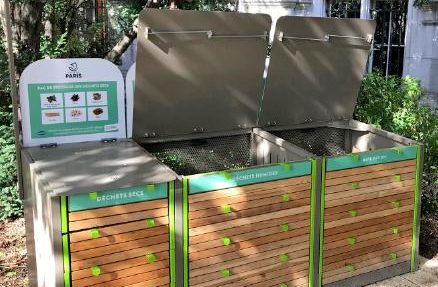Bio-waste represents 1/3 of our waste bins, and it could be recycled. As not everyone can have a composter, and in view of the law on ecological transition requiring European Union countries to set up source separation of bio-waste by 31 December 2023 at the latest, the introduction of collective composting in all French towns is becoming obvious. But it’s not that easy to install everywhere! We help you to decipher this phenomenon.
What is shared composting?
It is the possibility of practising composting on the scale of a district, a town, a shared composting site with an adapted installation. The neighbourhood composter allows residents who cannot compost at home to reduce their waste production (by reducing the quantity of bio-waste in the green bins) while making an eco-citizen gesture. This gesture allows them to reduce the cost of collecting and treating their waste.
The system consists of 3 bins: a deposit bin for compostable waste (fruit and vegetable peelings, coffee grounds and filters, grass clippings, etc.), a dry matter bin to store the structuring material (dead leaves, wood chips, etc.) to be added to the waste at each deposit and a maturing bin to store the compost in the process of being transformed.
Positive impacts at all levels
Make significant savings : the cost of treating biowaste is high, but when compared to a neighbourhood or even a town, it can quickly represent significant savings for the community. Moreover, by using a composter you produce free fertilizer that you can then reuse.
Create a friendly exchange place because by bringing the waste to the composter you will meet your neighbours and animate your neighbourhood. Setting up a composter also has an educational function for both children and adults.
Help reduce your ecological footprint by reducing the volume of bio-waste to be transported and processed. The waste brought to the composter, once recycled, is transformed into natural fertilizer that households can use directly for their plants.
How to set up a collective composter ?
- Form a group : this group will be responsible for setting up the project and raising awareness about composting.
- Define a suitable location : where will the composters be installed? The bins must be in a discreet place, inaccessible to animals, sheltered from the wind and in the shade.
- Establish the number of participating households and the list of stakeholders : residents, caretakers, owners, etc. who may be concerned by this project in order to plan the necessary installations.
- Plan the communication : communicate about the composter so that it is used wisely (what to put in a composter? how to use it?…)
- Plan the animation and the life of the composter (Master composter, referents of the site, educational visit…) : in order to animate the point and make it live
- Organise the distribution of the compost once it has matured : organise the distribution between users after 10-12 months, the compost can then be used as fertiliser in the gardens.






